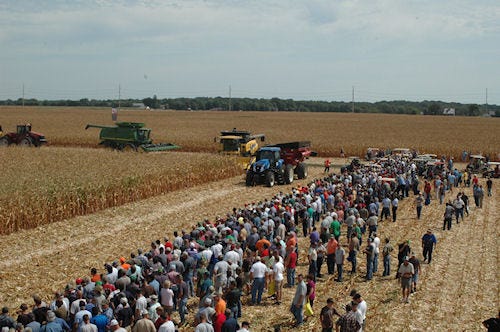July 6, 2016

If you want to see what a tool can actually do instead of just visualizing it in your head while you look at it in an exhibit or showroom floor, come to the Farm Progress Show. Field demonstrations have been a hallmark of the show since the first show in 1953, and are just as important today. The type of demonstrations has changed with the times, and will be tweaked again this year to in response to the latest trends in agriculture.

WATCH AND COMPARE: The field demos give you an opportunity to see what various colors of equipment can do side-by-side.
"We intend to run demonstrations every day, weather permitting," says Matt Jungmann, show manager. "We will do our best to let you see the equipment operate in the field as long as the weather conditions are such that it is safe and the tools can perform reasonably well."
Here are 12 tips which will help you get more out of this year's field demonstrations
1. Study field demonstrations map: The map printed here shows where intended harvest should happen each day.
2. Stay alert for last minute changes: If weather or other factors force changes to the schedule, Jungmann and Rick Wild, operations manager, will make every effort to notify visitors through as many mediums as possible. Follow us on Facebook and Twitter, watch for updates on our website and listen for loud speaker announcements.
3. Utilize trams if you need them: This is a walking show. However, as the demonstrations move farther back in the field, you may want to consider riding trams to and from the exhibits. The trams will load and unload at the spot marked on the map, at the north end of Central Avenue. Trams will also take visitors to the tiling demonstrations.

12 Tips For Getting Most From Field Demos
4. Know times of various demos: Combining is scheduled from 11 a.m. to 1 p.m. CDT each day. Tillage demonstrations will run form 2 p.m. to 3.p.m. CDT all three days. Twin-row corn will be combined the first two days, and 30-inch corn will be harvested the final day.
5. Safety first in the field!: Members of the field crews wearing orange vests will help facilitate the demonstrations. Please follow their instructions. A rope is used to designate how far you can come toward the tillage demonstrations. Please respect the rope and follow directions.
6. Mark pass of first run: Lovig intends to label the first pass of each piece of tillage equipment this year. This will allow you to see what the field looks like after that piece of equipment runs as you are allowed to move across the field.
7. Use golf cart only if necessary: Too many golf carts congregating near tillage demonstrations cause problems for organizers and other guests. If you must use a golf cart to attend the tillage demonstrations, please stay behind the roped area and be courteous to others trying to watch the demos.
8. Two operating speeds: There will be two speed categories for tillage equipment, since some implements, especially vertical tillage implements, need to operate at faster speeds. One group will consist of those operating at five miles per hour and below, Lovig says. The other will consist of equipment running six miles per hour or faster.
9. Moldboard plows return!: At least three companies plan on demonstrating moldboard plows at this year's show. They will run as part of the regular tillage demonstration.
10. Drill and planter demo: These also return to the show this year. Each operator will plant a short distance, then stop and explain their equipment to visitors.
11. Ride and drive: Several companies will offer ride and drive opportunities on everything from large tractors to sprayers and precision equipment. Ride and Drive areas are marked on the exhibit field map.
12. Confirm what tools are running: If you want to see a specific tool run, visit the exhibit for that company before the exhibit time. Find out which tools they're demonstrating in the field. Some companies may choose not to demonstrate all tools. Others may operate prototype machines in the field that aren't on their lots.
You May Also Like




